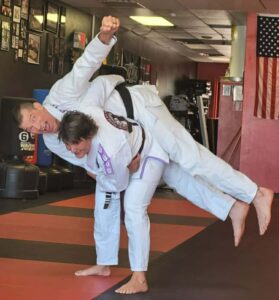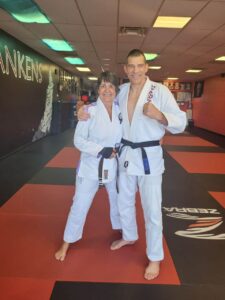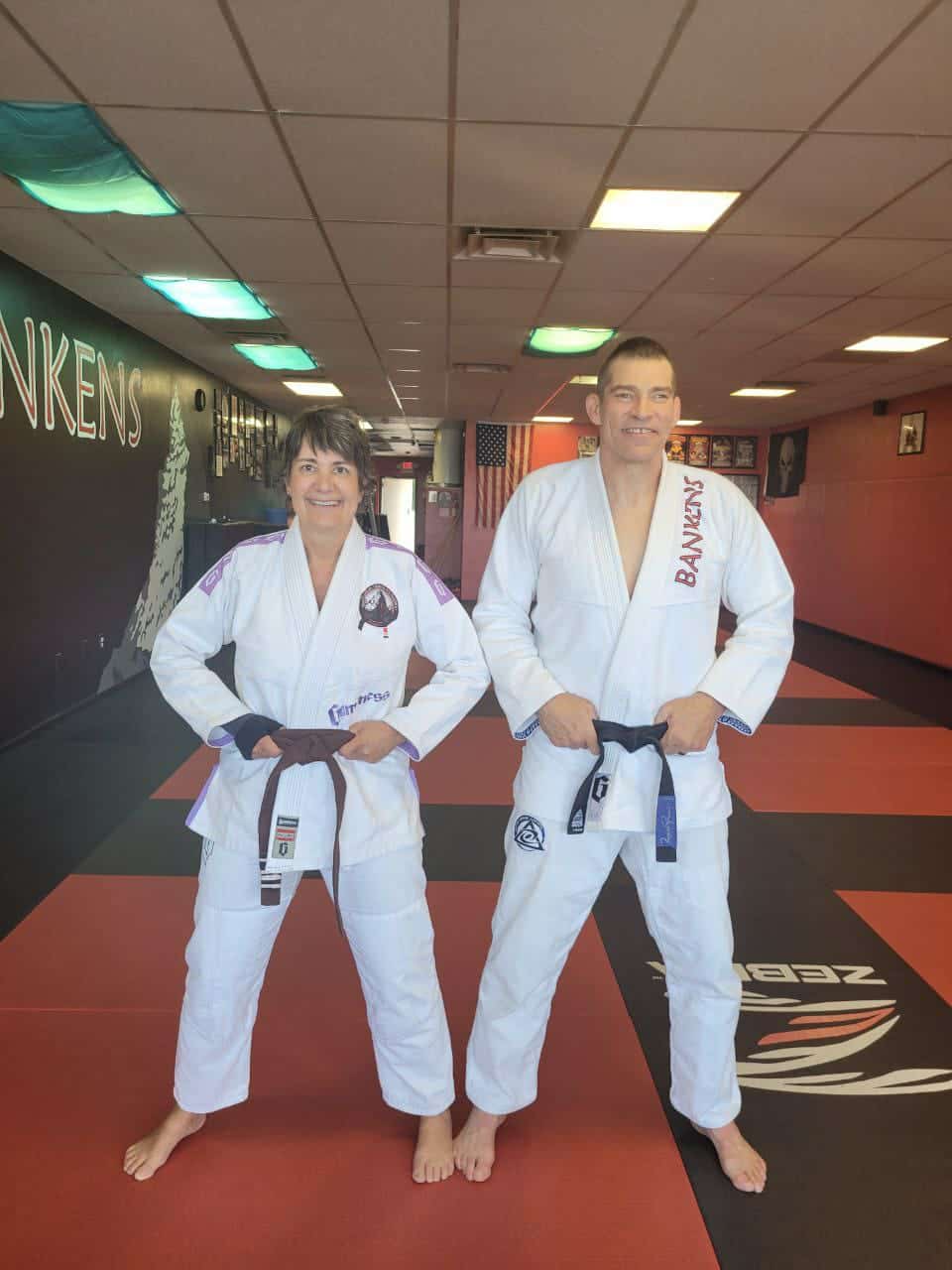Dr. Hart: How Jiu-Jitsu Training Enhances Her Medical Expertise in Sports Injuries
Dr. Hart has built an impressive career in medicine, specializing in the treatment of sports injuries. But what makes her expertise unique isn’t just her years of medical training. It’s her deep commitment to Brazilian Jiu-Jitsu (BJJ) that sets her apart as a physician who not only treats athletes but understands them on a personal level. Dr. Hart trains at the prestigious Valente Brothers Jiu-Jitsu Academy in Miami and with Professor Bankens at Bankens MMA in New Mexico, and her training in the martial art has profoundly influenced her medical practice.
In this blog, we’ll explore Dr. Hart’s journey in Brazilian Jiu-Jitsu, how her training has helped her understand sports injuries better, and how it has improved her overall approach to patient care.

1. Dr. Angelique Hart’s Jiu-Jitsu Journey: From Practitioner to Physician
Dr. Angelique Hart isn’t just a doctor with an interest in sports; she’s an avid practitioner of Brazilian Jiu-Jitsu (BJJ). Her passion for the martial art began several years ago, when she sought a way to balance the mental stress of being a physician with physical activity that could sharpen her reflexes and focus.
Training at Valente Brothers Jiu-Jitsu Academy
One of the most prestigious BJJ schools in the United States, the Valente Brothers Jiu-Jitsu Academy in Miami, has become a cornerstone in Dr. Hart’s development as a martial artist. The Valente Brothers’ approach emphasizes self-defense, discipline, and respect, qualities that have translated into her medical practice.
The Academy’s lineage goes back to the origins of Gracie Jiu-Jitsu in Brazil, making it a respected institution for both beginners and seasoned practitioners. Under the guidance of the Valente Brothers, Dr. Hart has honed her skills in technique, strategy, and injury prevention, learning firsthand the physical and mental demands that athletes experience.
Training with Professor Bankens in New Mexico
When she’s not training in Miami, Dr. Hart practices at Bankens MMA in New Mexico with Professor Bankens. His academy is known for blending various martial arts, including Brazilian Jiu-Jitsu, Muay Thai, and Judo. Professor Bankens focuses on creating well-rounded martial artists, and his emphasis on physical conditioning and injury prevention aligns perfectly with Dr. Hart’s professional focus.
This balance of traditional BJJ training and modern MMA techniques provides Dr. Hart with a holistic understanding of how the body moves, reacts, and recovers—crucial insights for her medical work.
2. How Brazilian Jiu-Jitsu Training Helps Dr. Hart Understand Sports Injuries

One of the most profound impacts of Dr. Hart’s jiu-jitsu training is her enhanced understanding of the biomechanics involved in sports injuries. As a practitioner, she’s not just observing injuries from the outside; she’s experiencing the physical demands and potential risks that come with intense athletic activity. This gives her a unique perspective that allows her to:
- Identify Injury Patterns: From hyperextensions and joint dislocations to concussions, BJJ places the body in various positions that, when understood properly, can help in identifying and diagnosing common sports injuries.
- Apply First-Hand Knowledge: Dr. Hart’s first-hand experience with injuries like sprains, bruises, and muscle tears enables her to empathize with her patients and provide more effective treatment. She knows what recovery feels like because she’s been through it herself.
- Develop Customized Treatment Plans: Because she knows the limitations and recovery timelines of athletes, Dr. Hart is better equipped to create customized rehabilitation plans. She understands the importance of mobility, flexibility, and strength in the healing process.
3. A Deep Understanding of Injury Prevention
Brazilian Jiu-Jitsu isn’t just about competition; it’s also about injury prevention. The techniques taught at Valente Brothers and Bankens MMA stress the importance of proper body mechanics, muscle balance, and movement patterns, all of which are key to avoiding injuries.
Body Awareness and Control
In BJJ, practitioners must be hyper-aware of their body’s positioning to both execute moves and protect themselves. This awareness has sharpened Dr. Hart’s ability to anticipate and prevent injuries in both herself and her patients. The precise movements required in jiu-jitsu translate directly to a better understanding of the body’s biomechanics, which is invaluable when diagnosing and treating sports injuries.
Prehab: Preparing Athletes for the Demands of Sport
Another key concept Dr. Hart has integrated into her medical practice is “prehab” or pre-emptive rehabilitation. Through her training, she’s learned exercises and conditioning techniques that help athletes strengthen their bodies before injuries occur, reducing the risk of common sports-related problems like knee injuries, torn ligaments, or back pain.
4. Jiu-Jitsu as Therapy: The Mind-Body Connection
As a physician, Dr. Hart recognizes the importance of the mind-body connection in healing. Brazilian Jiu-Jitsu is a discipline that demands mental focus, problem-solving, and emotional control, all of which contribute to overall well-being. Training in BJJ has given her insights into how athletes deal with mental stress, and she applies these lessons to her patients.
Mental Resilience and Healing
Jiu-Jitsu teaches resilience—not just physical toughness, but mental fortitude. The ability to remain calm under pressure and overcome adversity on the mats mirrors the psychological strength needed in recovery from injury. Dr. Hart encourages her patients to develop similar mental strategies to stay positive and motivated throughout their rehabilitation.
5. Improved Doctor-Patient Communication
One of the most important but often overlooked aspects of medical care is communication. Dr. Hart’s experience as both a physician and a martial artist allows her to connect with her athletic patients on a deeper level. She speaks their language, understands their concerns, and can offer practical advice that resonates with them.
Trust Through Shared Experience
When athletes know that their doctor is also a fellow practitioner, it fosters trust. Dr. Hart’s credibility is enhanced because her patients know that she’s faced similar challenges and understands the physical demands of training and competition. This shared experience strengthens the doctor-patient relationship and ensures that patients feel confident in her treatment plans.
6. Practical Applications: Treating Common BJJ Injuries
Brazilian Jiu-Jitsu, like any sport, comes with its own set of common injuries. Dr. Hart’s extensive training in the sport has given her specialized knowledge in treating:
- Knee Ligament Injuries (ACL, MCL): These are common in BJJ due to sudden pivots or torque on the joints during grappling.
- Shoulder Dislocations: Submissions often target the shoulder, making dislocations or tears prevalent.
- Neck Injuries: Strains or disc issues in the cervical spine can arise from the strain placed on the neck during certain positions.
- Concussions: Although less common in BJJ than in striking martial arts, head trauma can still occur, especially during takedowns.
Her dual perspective as a doctor and practitioner allows her to not only treat these injuries effectively but also educate her patients on how to prevent them in the future.
7. Conclusion: The Symbiosis of Martial Arts and Medicine
For Dr. Angelique Hart, Brazilian Jiu-Jitsu is more than just a hobby—it’s a critical aspect of her identity as both an athlete and a physician. Through her training at Valente Brothers Jiu-Jitsu Academy and Bankens MMA, she has gained invaluable insights that enhance her ability to treat sports injuries. By blending the physical, mental, and medical aspects of martial arts, Dr. Hart provides her patients with comprehensive care that goes beyond traditional medicine.
